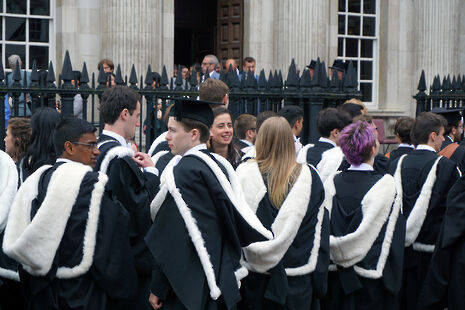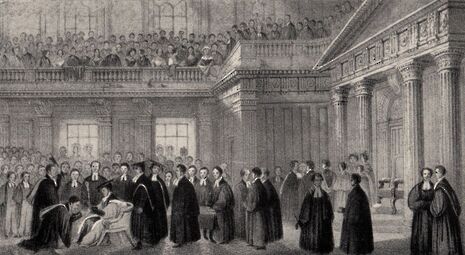Class Lists: How the story unfolded
Sam Harrison brings Varsity up to date on the controversial debate over the future of Class Lists, and notes how the parameters have radically shifted in the past six years

A debate over the future of publicly displayed Class Lists – lists of student names their exam grades posted outside Senate House – will come to a head this term with votes among the student body and senior academic staff over their future. This is the result of a campaign by students and academics stretching over a year and a half.
On the 17th May 2015, the student campaign Our Grade, Our Choice set up a petition on Change.org, calling for the University to create an opt-out system for Class Lists that would be based solely on each student’s preference, to replace the extant arrangements, which require that a student provide a valid reason for their wish not to have their grades displayed publicly.
Our Grade, Our Choice argued that the traditional arrangement “completely ignores the right of privacy for Cambridge students, and their welfare”, denies students control over their results, and generates “a culture of grade shaming”. It also raised concerns over the impact of Class Lists on students with mental health issues, and the failure of Class Lists to contextualise results. The campaign claims that within 24 hours the petition had gained more than 500 signatures. By the time it closed, it had more than 1,300.
The petition was sent to the University, along with a number of testimonials written by students, at the end of May. In October, Our Grade, Our Choice was informed that one of the University’s committees, the General Board’s Education Committee, had considered their case and backed a review of Class Lists.
In November, CUSU entered the fray, with its Council voting 20 to zero in support of the abolition of publicly displayed Class Lists, with four abstentions, mandating then-president Priscilla Mensah to call for an end to the practice.
In April 2016, Varsity revealed that the General Board of the Faculties had requested that a proposal be put to the University Council recommending the abolition of Class Lists. Although this went beyond Our Grade, Our Choice’s original call for more students to be permitted to opt out of the public displaying of their results, the campaign immediately welcomed the announcement. It later told Varsity that it had considered calling for the abolition of class lists on the original petition, but decided that abolition was most likely to be achieved through piecemeal reform, adding: “We welcomed, and still welcome, the University’s stance on Class List abolition. We believe that it is ultimately the final step in ending an archaic and outdated system.”
The proposal followed a circular distributed in November 2015 to colleges, faculties and departments requesting opinions on the abolition of Class Lists. The majority of respondents backed abolition on the condition that the relevant information regarding grades still be made available internally. Just one college expressed support for the status quo.
Almost immediately, however, a reaction developed in defence of Class Lists. The campaign ‘Save The Class List’ was established, creating its own petition which called for a referendum on CUSU’s stance, complaining in the rubric of the petition that the decision had been taken “without students being consulted”. It made clear that it would campaign for the preservation of Class Lists in a referendum. In July, the group announced that it had surpassed the 350 signatures required to trigger a referendum of the student body. They claim that 700 current and former students and fellows signed in total.
In July, a ‘Grace’ (a formal notification of a pending change to the University’s statutes) proposing the abolition of Class Lists was submitted to Regent House, the body comprising senior academics and staff which is empowered to make the final decision on the issue. Such a proposal is passed automatically provided that it does not receive formal dissent from more than 25 of its members. However, in a new twist, 55 members of Regent House requested a formal vote on the issue. This vote will take place towards the end of Michaelmas term.
The student referendum will be held shortly after CUSU forms a new committee to host elections, so will likely occur before the vote in Regent House. It can only change the stance CUSU takes on the issue; it cannot directly influence the decision taken by the University. However, many believe that it will act as a proxy for the vote within the University, by persuading open-minded fellows of the direction of student opinion.
At the time of the petition’s submission, a spokesperson for Save The Class Lists said that the campaign believed “that members of University Council were in favour of the change because they thought that this is what students wanted”, and added that “A successful referendum would change that perception.” At least some University staff seem to be interpreting the vote in the same way: Professor David Tong told Varsity that he was “happy to be guided in [his] vote by the result of the student referendum.” Save The Class Lists also told Varsity that CUSU, under new president Amatey Doku, would be obliged to lobby the University for an enhanced opt-out if it became the Union’s stance, which would strengthen the case for that reform.
According to current plans, the fate of Class Lists will be decided by two votes in Michaelmas term. The first of these will be the referendum, in which all students will be permitted to vote. This will probably ask the student body to decide whether or not CUSU’s official stance on Class Lists will be in favour of their complete abolition. Save The Class List is hoping that CUSU will adopt a stance in favour of an enhanced opt-out system that would not require a reason to be given for opting out.
A vote in Regent House against the motion will push the campaign to abolish or reform Class Lists back to square one, and could silence the issue for some years. If, however, the motion receives the assent of Regent House, the practice of publicly displaying Class Lists will, after three centuries, become extinct in Cambridge.
History of Class Lists

The 17th-century forerunner of Class Lists was the Ordo Senioritatis (literally: ‘order of seniority’), which awarded most a simple ‘pass’, and did not rank them according to attainment, though it did name a few of the most accomplished students in an ‘order of merit’. In the 18th century, however, rankings according to merit displaced simple lists: from 1710, students in the Ordo’s ‘order of merit’ were subdivided into ‘Senior Optimes’ and ‘Junior Optimes’, and in 1753 another class was added above those, that of ‘Wrangler’ (so called because of their skill in argument). The rest of the student body were designated ‘hoi polloi’ (from Greek ὁι πολλοι, meaning ‘the multitude’ – a disparaging term for the populace at large), or ‘Pollmen’.
Examination results in Mathematics, then a compulsory subject, were first printed and publicly displayed in 1748, 18 years after the construction of the Senate House. Partly this was a result of the formalisation of the examination system, which made exams a much more gruelling ordeal than they had previously been. The account of one student taking those exams might be familiar to some modern Cantabs: “It was hardly ever my lot, during that examination, to enjoy any respite… My constitution had just held me up to the expiration of the scrutiny, and I immediately hastened to my own home to alarm my parents with my ghastly looks, and soon fell ill of a rheumatic fever, which for the space of six months kept me hovering between life and death.”
Class Lists for other subjects only developed later, usually as those disciplines came to be taught at the University. A Class List was created for Classics in 1824, for Natural Sciences in 1851, for History in 1875, and for most other subjects still taught at the University between 1905 and 1965.
Until 2010, results were publicly displayed before students had been made personally aware of them. However, a change that year saw students being able to access results online before they went on public display. This followed a campaign by CUSU, which claimed that the previous system caused “a lot of student anxiety”. At that time, CUSU also advocated the implementation of the same preference-based opt-out system now advocated by the Save The Class List campaign: that the radical option in 2010 is now favoured by defenders of Class Lists is an indication of how far the parameters of this debate have shifted in the last six years.
 News / Cambridge academics stand out in King’s 2026 Honours List2 January 2026
News / Cambridge academics stand out in King’s 2026 Honours List2 January 2026 Interviews / You don’t need to peak at Cambridge, says Robin Harding31 December 2025
Interviews / You don’t need to peak at Cambridge, says Robin Harding31 December 2025 Comment / What happened to men at Cambridge?31 December 2025
Comment / What happened to men at Cambridge?31 December 2025 News / AstraZeneca sues for £32 million over faulty construction at Cambridge Campus31 December 2025
News / AstraZeneca sues for £32 million over faulty construction at Cambridge Campus31 December 2025 Features / “It’s a momentary expression of rage”: reforming democracy from Cambridge4 January 2026
Features / “It’s a momentary expression of rage”: reforming democracy from Cambridge4 January 2026









